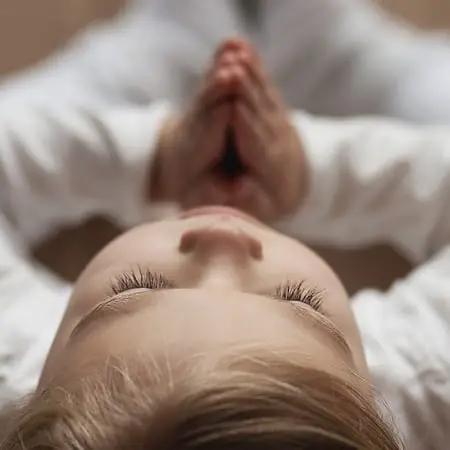Both meditation and prayer have been essential arts in the course of human history. They are both used in the search for a deep level of peace, find connection within the unexplored parts of the human soul, and experience ultimate meaning even during the most adverse times.
Though they have some similarities — and indeed align in various ways — it is still worth taking a deep look at the two practices to see where their unique applications end and begin.
There are 9 main Difference between Prayer and Meditation:
1. Prayer is to speak; meditation is to be spoken to
2. Prayer is outward; meditation is inward
3. To pray is to seek, to meditate is to accept
4. Prayer is dependent on belief, meditation is independent of it
5. Sensation and perception feel different
6. Prayer is easy for youth, while meditation often requires maturity
7. Meditation and prayer vary in duration
8. Prayer is relational, meditation is individual
9. Meditation focuses on the present, while prayer can be and future oriented
We will look into these differences between prayer and meditation and reveal their individual qualities that will help define what each practice really is and means. Some of the points may even appear to contradict each other upon first glance, but the apparent tensions are necessary to sharpen one’s understanding of each practice and to bring a more vibrant picture of their differences to life.
Prayer is to speak; meditation is to be spoken to
Prayer is concerned with talking, conversing, and making requests be known. Meditation is concerned with a stillness, where one serves as a witness of one’s own mind in order to listen and observe what is occurring within.
The mind is busy. Whether or not we are aware of it, it is always saying things, making judgments, and considering possibilities. Tapping in to interrupt this process allows one to grow conscious and attentive to the words that the internal self speaks. Meditation does not allow the secret meeting in the basement to continue without knowing what is being said.
Prayer is outward; meditation is inward
Prayer is concerned with reaching out in order to touch an entity beyond oneself. Though the issues raised in prayer may be internal in nature — such as fear or shame — the place that those issues are brought to is still outside of oneself, whether it be a god, transcendent force, or an unknown entity. Meditation steers within and is not seeking to connect with a greater power necessarily.
To pray is to seek, to meditate is to accept

Meditation is an art that does not seek to defy, change, or otherwise alter reality. On the topic of stillness, meditation seeks only to tap into reality on a truer level, and is not initially concerned with changing it.
Prayer is forward-facing, reaching out for change, primarily with an eye for the way things could be. This does not mean that meditation teaches helplessness, or that prayer cannot handle reality. Instead, it means that meditation does not ask if what is present is enough or not, but simply works within the confines of what already exists; and that prayer is looking for understanding, protection, and blessing for what is around the corner.
Yet, both prayer and meditation require each other. To get where one is going, one must first find out where one is; and, alternatively, to move out of where one is, one has to know where one is going.
Prayer is dependent on belief; meditation is independent of it
A Christian, Muslim, Buddhist, and Secularist all believe different things about the world, what is true, and what is important. They also all pray — (those who pray) — differently. Because of the variety of beliefs and traditions, their prayer will look different, sound different, and fundamentally be different from each other.
Adhering to a different belief system changes one’s prayer. Meditation, however, transcends differences and, though there are variants within the meditative practice, the core elements of meditation can be used by all.
Sensation and perception feel different
Since meditation is concerned with the here and now, and draws one’s attention into the sensations that one feels in the body — and the thoughts that move through one’s head — it is primarily concerned with the sensory abilities of the human.
This inclusive dichotomy of thoughts and feelings under the umbrella of “sensation” points to the essence of what meditation is: awareness. It is not only being aware of the voices that speak inside one’s head but of how one’s body feels. From the muscle aches to the tight shoulders, to the short shallow breaths, meditation helps one grow conscious of the state that the body and mind are in.
Meditation taps in and listens to the communication signals that the body is sending, and brings the somatic language into the light.
Prayer is searching for a sign. It actively perceives for connection, response, and the voice beyond one’s own mind. It is the sensation of a different realm, growing ever in-tuned with the divine conversation and the leadings of one’s spirit.
Prayer is easy for youth, while meditation often requires maturity

Both prayer and meditation require practice to grow comfortable and adept at. But, where meditation requires a growing of attunement to the subtleties of the body and mind, prayer can simply be a reaching out.
Children rarely have the capacity to be still and attuned in the way that meditation requires. But prayer, whether it be for request, giving thanks, reaching out to God, gods, or some other force, is open to all those of all ages — once the capacity for speech and imagination are obtained.
In fact, prayer may even be easier for children, whose ability to connect with the unseen is far greater than most adults.
Long and short
Though meditation and prayer vary in duration and in the intensity of focus, meditation is usually a longer practice with sustained focus, and prayer is briefer and requires only a more relaxed focus.
Meditation is a discipline that sharpens the muscles of awareness and concentration, and it is more self-sustaining and empowering. Though prayer can be ritualistic, it can also be unceremonious and does not require sustained blocks of concentration to conduct. Prayer is requesting the assistance or presence of another force or entity.
Prayer is relational; meditation is individual
A prayer is an act that aims to join with another. It is fundamentally relational. Many have even described prayer as being a “conversation with God.” Indeed, not all prayer is about asking or even giving thanks for life.
For example, in the Christian religion, one of the apostles says to “pray at all times.” He is not speaking about always asking for things as if God were Santa Claus, and every day was Christmas. Instead, he points to an essential idea of a relationship, a two-way back and forth between oneself and a divine entity.
Jungians or psychologists may refer to this as having interactions with one’s own psyche or conscience, but even still, they do not resist an explanation of dual-naturedness. Deep prayer becomes about entering the conversation with this “Spirit,” whatever it may be.
Meditation is not focused on connecting with an outside source, but obtaining unity and clarity within. It is not selfish, but it is self-focused. If the “unexamined life” is really not worth living, then meditation stands as a necessary piece that leads to unity of self. To meditate is to become well versed with the contents and proclivities of one’s own nature, spirit, or psyche.
Meditation focuses on the present, while prayer can be future-oriented
Meditation is not done in an attempt to really change anything. It is instead drinking deeply of what already is. It is concerned with what is here and now, what one is feeling both emotionally and physically, as well as the train of chatter and ruminations occurring in one’s mind. Meditation aims to accept reality as it is and not to judge it. Yet, if one does judge reality, meditation merely grows aware that one is doing so, without acting upon the judgment.
The prayer is not the same. Prayer is primarily focused on the future, about what could be. It does not require an attunement with the present moment, but an articulation of a possible future image.
When one is anxious about a job interview or a test, or when a friend or family member has become gravely ill, prayers are given for the future success or healing of those problems, respectively. In those situations, meditation is used to settle in and provide the anxieties and fears room to be felt, understood, and to wash through. But prayer is given in desire for a change of circumstances, whether internal or external.
Where Does Prayer Originate From?
Prayer is most closely associated with monotheistic religions such as Christianity, Islam, and Judaism. The origins of the modern understanding of prayer come from the understanding that prayer is connecting with the divine, making requests, and sharing an intimate space. This is best understood if the other sharing the space is a one.
Prayer is making a prayer to someone or something else. It stands to reason that the concept of prayer shines brightest in monotheistic religion — where a belief in a single God, with whom communication is possible, stands as a pillar of each of the major monotheistic religions.
What about prayer for nonmonotheistic religions?

Surely Buddhists, Hindus, and others still pray — or do their prayers somehow not count because they are not directed at a single entity? Humans are in desperate need of orientation, where the path or process of something is laid out in an understandable way.
This is one of the draws of monotheism, where everything is directed back to a single source. Yet, a similar motive exists in many of the eastern religions. Many of whom’s ultimate goal is to reconnect with a transcendent “oneness” and escape the life that has separated oneself from the source.
As an example, let’s take the personality theory known as the Enneagram. The Enneagram posits that each of the types feels a distinct lack within themselves — as if an essential piece has been fundamentally lost. And, though each piece is different, the motive for all nine types is the same: to get back to a state of oneness that seems to have been forgotten once humans became conscious.
One could say that, regardless of religious orientation, this is the same motive shared with those who pray. Prayer is a desire for connection, to fill something that seems lacking, and to search for that sense of oneness, where the world starts to fall away. All that is left is a place that is almost imperceptible, but unmistakably home.
This is why prayer practitioners, whether they be religious or not, use words like “the universe” or “the cosmos” as a destination of their prayers. This is where ideas like the law of attraction find life because some intention from a force outside of human will is allowed to exist even without a philosophy of an individual divine entity.
Where Does Meditation Originate From?
Meditation has a rich history, which originated undoubtedly from the east. India has been pinned as the oldest traceable source of meditation — dated somewhere around 1500 BCE. Some believe it is even older than this, reaching as far back is into 3000 BCE into the dim lights of anthropological origin.
The word itself comes from the Latin word meditatum, which means “to ponder.” One could say that the first person who pondered anything was the sole originator of mediation. If evolution is adapted as a historical view, then mankind’s self-awareness was something that they had to learn as they became less communal and more individual within their own minds.
This would put prayer as a much older practice than meditation. But, if creationism from divinity is accepted, then meditation could be as old as humankind is.
Scholars cannot know for sure when meditation originated from in ancient history, but the modern historical tracing is a little more straightforward. India, China, and Japan can all claim significant influence in the origins and development of meditative practice. India gave birth to Buddha, and from him came Buddhism — and the ensuing spread of mediation.
From China came Laozi, who is credited with writing the ancient text of the Tao Te Ching, and with the founding of Taoism. One of Taoism’s core principles is learning to abide in a state that strongly resembles meditation or “flow.” Lastly is Japan’s Dosho, who was said to have traveled to study Zen Buddhism, bringing it back to his home in Japan, where it spread to the whole country.
One could argue that prayer was a discipline that came with the west, whereas the east looked to meditation as their primary religious practice. This is an overly simplistic explanation, no doubt, but prayer seems to have attached itself to the western and/or monotheistic religious traditions. Meditation seems to have been propelled much more into the pantheistic/agnostic religions (Buddhism, Hinduism, etc.) than the monotheistic ones.
Still, Christians, Muslims, and Jews all have tenets of entering meditative states, and Buddhists and followers of other eastern religions pray to their figures, prophets, divinities, and entities.
Is Prayer A Form Of Meditation?
The basic histories and essential differences of prayer and meditation have been thoroughly explored; now, it’s time for the million-dollar question: are prayer and meditation really the same thing? As is the frustrating answer with many difficult questions, “it depends” is the best short answer. But how about the long answer?

In essence, meditation and prayer push energy in different directions. Though prayer may be used to navigate the internal body, mind, and spirit of a person, and meditation may be used to connect with an entity that may be communicating internally, the basic energy of meditation is moving inward, and prayer outward. But, the more the question is asked regarding their differences, the more the lines between them begin to blur.
Could it be that most people who practice both of these arts often do so simultaneously, or at least very close together? With a little examination, it becomes clear how meditation and prayer can work together.
One sits down on a rug or a couch, breathes deeply, and settles into their body. One feels the muscle ache in one’s calf and the tightness in one’s shoulder. With a deep breath, one releases the tension from both of these areas and settles into the body even further. Now one is ready to reach out, feeling the twang of a need to speak, to share, and to connect for relationship or guidance from another.
Closing thoughts
Even on their own, meditation can be prayerful, and prayer can be meditative. They are linked so closely together and one can see how they can be used as different sides of the same coin, or two different practices with a similar goal: peace and wholeness. What has been discussed above are not indisputable facts, but tendencies that help to reveal the distinctions between prayer and meditation. The movement of mediation being inward, and prayer outward is the same movement as a breath that moves in, and then the breath that is let out. The breath taken in is a gift from nature. The gift is returned again on the exhale, and nature takes it back only to give it again, so that one can continue to live.








